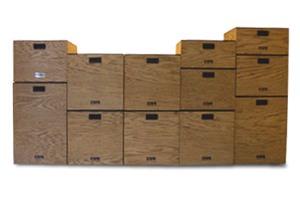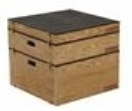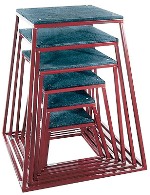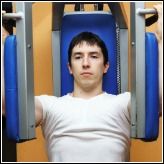Plyometric Box

A plyometric box has many uses and there uses are as varied as the sport and the athletes who might have a need for them.
All elite sports people should use boxes to exploit the latent potential of stored elastic energy which is available in all dynamic movements. More specifically, in sports such as track & field, volleyball and basketball, athletes might use a plyometric box to pressure test technical elements of their event before taking it to the competition arena.
Other sports such as American football and rugby would use plyo boxes for the type of exercises explained above but, might specifically employ exercise where they would “jump onto” as oppose to “off and on” the plyometric box. In this case they are hoping to promote explosive concentric strength.
So, you can see, these boxes have many uses…
Wooden Plyometric Box

Boxes are available in a variety of materials. However, my favorite type of box is one that is made of wood. I am from a track and field background and for me plyometric boxes need to function on several levels. For instance, I use boxes to:
Why wooden boxes?
Well wooden boxes tend to deform on impact and then quickly reform. This has two benefits. First, the deformation absorbs some of the shock of landing on the box. Secondly, when the box reform, this gives back to the athlete some of that stain energy which was created when the box top was deformed. What this achieves is when performing drills such as box jumping, (Watch the video) athletes are able to focus on the work that is done on and from the ground and not the box top.
Other common types of boxes are either made of solid metal or a combination of a metal frame with wooden tops. I am not too keen on these as the only drills I can perform with these types of boxes are “depth jumps” and probably “concentric power jumps”. Anecdotally, I also find that most athletes - from a psychological point of view - don’t want to jump on and off solid metal boxes!
Storage

For ease of storage some boxes are constructed in such a way that they fit into each other like a Russian doll. And although this is a good idea from a storage point of view, it does mean that the lower height boxes have a smaller surface area for the athlete to land on. Boxes that are designed to store in this way tend to have tops that are too small for repeated “box jumps” type drills or technical work.
Like most plyometric box, wooden ones can be stackable, thereby saving on storage space. Where possible, I would also encourage you to source boxes which fit together like a gymnastics horse (one on top of the other). These types of boxes have several base units that are 6 to 8 inches and come with the possibility of several box tops.
The optimum ratio is have 4-5 base units and 4-5 box tops. The advantage of this arrangement (depending on the number of base units and box tops) is that it gives you the widest possible flexibility of heights and number of boxes for athletes of different abilities while still maximizing your storage space.
Weight Versus Strength
Wooden boxes are normally made from multi-layer plywood which makes for a strong but light construction. The corners and the box tops should be reinforced with solid wooden struts. If the boxes are just glued and screwed, and they are in constant use, be careful as they will eventually weaken and begin to fall apart – sometimes at the most inopportune moment.
You can also have your box built out of solid wood. This makes for a much stronger construction, but it will also be heavier. There are several sites on the net which will explain how you can build your own boxes in this way. However, the best retailers will stock a variety of boxes to suit most needs. So, you will only need to have boxes built for very special reasons.
So, because of there versatility, if I had a choice, I would choose a wooden plyometric box over any other every time.
Sign Up For The Latest Track And Field News And Improve Your Athletic Performance!
From "Plyometric Box" Back To "Faster, Stronger, Better – Your Shortcut To Improved Athletic Performance"
Learn more about plyometric training







